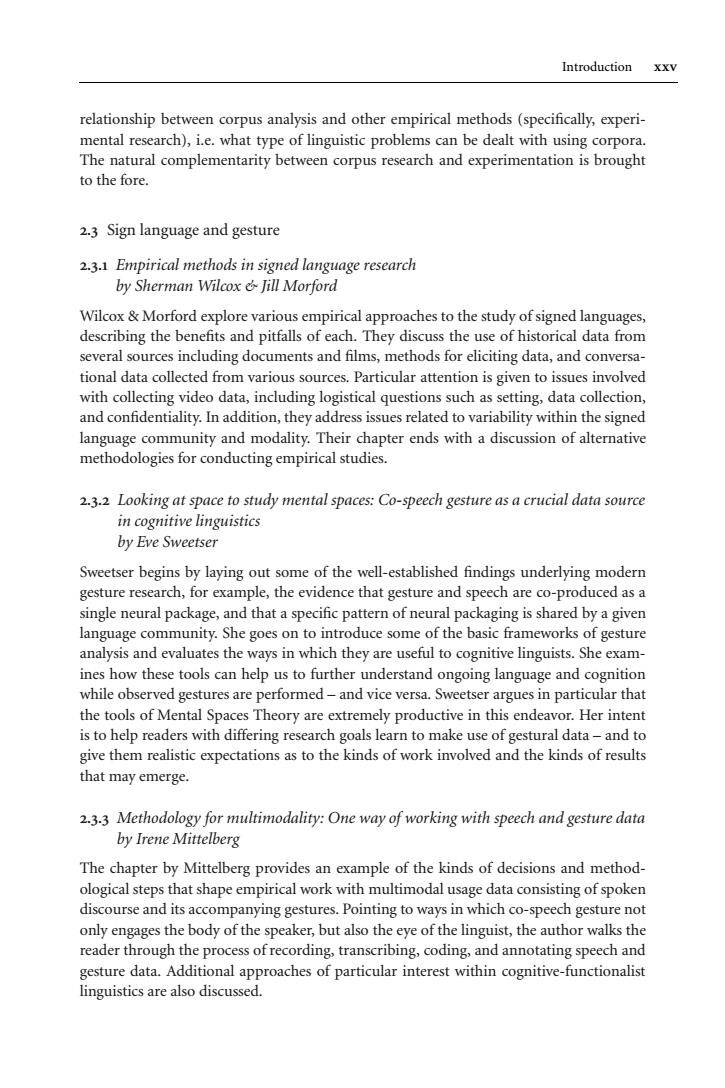正在加载图片...

Introduction XXV relationship between corpus analysis and other empirical methods(specifically,experi- mental research),i.e.what type of linguistic problems can be dealt with using corpora. The natural complementarity between corpus research and experimentation is brought to the fore. 2.3 Sign language and gesture 2.3.1 Empirical methods in signed language research by Sherman Wilcox e Jill Morford Wilcox Morford explore various empirical approaches to the study of signed languages, describing the benefits and pitfalls of each.They discuss the use of historical data from several sources including documents and films,methods for eliciting data,and conversa- tional data collected from various sources.Particular attention is given to issues involved with collecting video data,including logistical questions such as setting,data collection, and confidentiality.In addition,they address issues related to variability within the signed language community and modality.Their chapter ends with a discussion of alternative methodologies for conducting empirical studies. 2.3.2 Looking at space to study mental spaces:Co-speech gesture as a crucial data source in cognitive linguistics by Eve Sweetser Sweetser begins by laying out some of the well-established findings underlying modern gesture research,for example,the evidence that gesture and speech are co-produced as a single neural package,and that a specific pattern of neural packaging is shared by a given language community.She goes on to introduce some of the basic frameworks of gesture analysis and evaluates the ways in which they are useful to cognitive linguists.She exam- ines how these tools can help us to further understand ongoing language and cognition while observed gestures are performed-and vice versa.Sweetser argues in particular that the tools of Mental Spaces Theory are extremely productive in this endeavor.Her intent is to help readers with differing research goals learn to make use of gestural data-and to give them realistic expectations as to the kinds of work involved and the kinds of results that may emerge. 2.3.3 Methodology for multimodality:One way of working with speech and gesture data by Irene Mittelberg The chapter by Mittelberg provides an example of the kinds of decisions and method- ological steps that shape empirical work with multimodal usage data consisting of spoken discourse and its accompanying gestures.Pointing to ways in which co-speech gesture not only engages the body of the speaker,but also the eye of the linguist,the author walks the reader through the process of recording,transcribing,coding,and annotating speech and gesture data.Additional approaches of particular interest within cognitive-functionalist linguistics are also discussed.JB[v.20020404] Prn:12/04/2007; 9:53 F: HCP18IN.tex / p.4 (242-317) Introduction relationship between corpus analysis and other empirical methods (specifically, experimental research), i.e. what type of linguistic problems can be dealt with using corpora. The natural complementarity between corpus research and experimentation is brought to the fore. . Sign language and gesture .. Empirical methods in signed language research by Sherman Wilcox & Jill Morford Wilcox & Morford explore various empirical approaches to the study of signed languages, describing the benefits and pitfalls of each. They discuss the use of historical data from several sources including documents and films, methods for eliciting data, and conversational data collected from various sources. Particular attention is given to issues involved with collecting video data, including logistical questions such as setting, data collection, and confidentiality. In addition, they address issues related to variability within the signed language community and modality. Their chapter ends with a discussion of alternative methodologies for conducting empirical studies. .. Looking at space to study mental spaces: Co-speech gesture as a crucial data source in cognitive linguistics by Eve Sweetser Sweetser begins by laying out some of the well-established findings underlying modern gesture research, for example, the evidence that gesture and speech are co-produced as a single neural package, and that a specific pattern of neural packaging is shared by a given language community. She goes on to introduce some of the basic frameworks of gesture analysis and evaluates the ways in which they are useful to cognitive linguists. She examines how these tools can help us to further understand ongoing language and cognition while observed gestures are performed – and vice versa. Sweetser argues in particular that the tools of Mental Spaces Theory are extremely productive in this endeavor. Her intent is to help readers with differing research goals learn to make use of gestural data – and to give them realistic expectations as to the kinds of work involved and the kinds of results that may emerge. .. Methodology for multimodality: One way of working with speech and gesture data by Irene Mittelberg The chapter by Mittelberg provides an example of the kinds of decisions and methodological steps that shape empirical work with multimodal usage data consisting of spoken discourse and its accompanying gestures. Pointing to ways in which co-speech gesture not only engages the body of the speaker, but also the eye of the linguist, the author walks the reader through the process of recording, transcribing, coding, and annotating speech and gesture data. Additional approaches of particular interest within cognitive-functionalist linguistics are also discussed